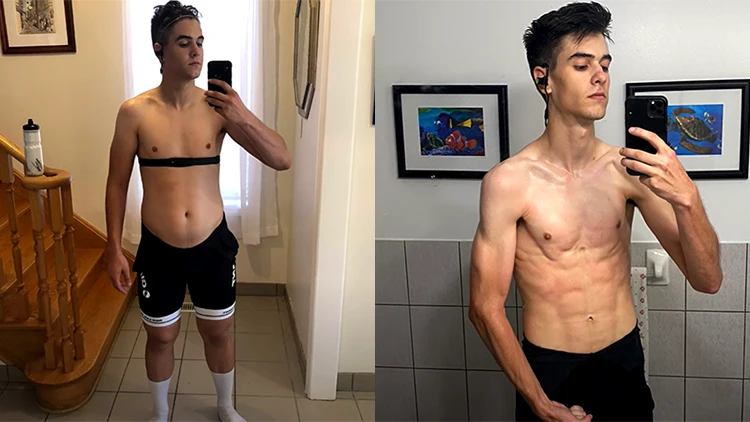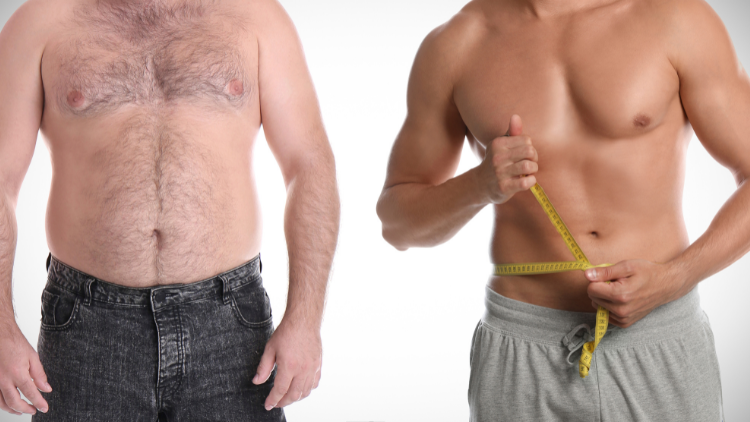
A cycling body transformation, male physiques in particular, can be very pronounced if done consistently and combined with the correct diet.1
With a little determination and effort, you will will be amazed by what 1-month exercise bike results can reshape your body and be used as momentum to achieve a body you’re proud of long term.
Is Cycling a Good Approach for Men to Achieve a Body Transformation?
Cycling is a good approach to achieving body transformation because it encourages weight loss, growth, and toning of muscles. Aside from causing body transformation, cycling positively impacts cardiovascular health and elevates moods, coordination, and posture, among other health benefits.2
While cycling is a low-impact exercise, it is an ideal way to thoroughly work the body and transform its physique. By cutting calories through proper nutrition, cycling will cause weight loss and build muscle. It improves brain health and tones the muscles—giving that chiseled look and cycling body type.
1 Month Cycling Body Transformation: Male (Before & After Results)
As seen in the image and video below, when a male cycles consistently for 1 month to a year, they will undergo a noticeable cycling body transformation with a clear distinction of before and after cycling. The same lies true for females on a cycling body transformation. The changes begin instantaneously after the first ride resulting in increased oxygen flow in the blood and increased metabolic rates.

Notice how in his before picture his stomach is bloated and his body is less defined but in his after picture losing at least 30 pounds, his body is very lean and his muscles and abs are more defined and clearly visible. Source: Pedaler on Youtube3
After 1 month of cycling, the body will have pronounced fat loss if the rider doesn’t eat to their heart’s content. Someone will have, among other things, changes in the lower body—the leg muscles become more developed—this is both in size and shape. The transformation type will also depend on the type of cycling sport engaged in—racing or non-racing cycling.4
Results can be achieved through all sorts of cycling from racing, road bikes, BMX, spin classes, Peloton, and more. Some types of intensive or hard cycling can expend up to 600 calories an hour.
How Cycling Transforms Males (Bodies, Physiques & Mentally)
A cycling body transformation of the male physique will lead to a transformation of male bodies in a multitude of ways with 1-month exercise bike results leading to health benefits and achieving a biking body transformation. Physiological transformations and manifestations of change will occur on the physical plane—altering their overall physiques—due to the targeting of the quads, calves, and glutes. Knee pain will lessen and cease due to more muscular cycling legs.
- Quads—cycling will increase the size of the quads. Those involved in elite cycling will likely have slimmer and much leaner legs. However, those concentrating on track cycling will have larger quads akin to those a sprinter would have. Cyclists who engage in heavy uphill cycling may develop a ‘teardrop-shaped muscle above the knee which is deemed to have an aesthetic appeal.
- Glutes—the glutes of the cyclists are also involved during a cycle. As a result, many cyclists have reported that they end up having more toned glutes but not necessarily bigger as cycling doesn’t recruit the glutes as much as the other parts of the leg.
- Hamstrings—the action of lifting the pedal during cycling will employ the hamstrings. This helps strengthen them and shape them. They will also end up getting stretched as a result of the mechanics of cycling.
- Calves— the calf muscles are heavily engaged during cycling when pushing down the pedal. Anyone who has looked at pro-cyclists calves is sure to be convinced of the effect on the calf muscle. The muscle will strengthen, increase in size, and significantly be toned.
Physiological Changes in Cycling Body Transformation (Male Body)
In addition to physical changes, cycling will induce improvements such as improved sleep cycles, boosted immunity, and enhanced digestion.
- Improved brain function and mood—cycling will catalyze the brain to increase blood flow throughout the body due to the demand placed on the body.5 The exercise will also improve brain function and health—mitigating risks like dementia related to old age. Moods also improve as a result of cycling.
- Heart health— it will improve cardiovascular health—the heart will be more healthy and more robust as a result of cycling, and there will be a reduction in the risk of stroke, heart diseases, and diabetes.6
- Sleep—males engaged in cycling will have an improved sleep cycle and reduce instances of insomnia. The rigor of cycling will tire the body—mental fatigue may not sometimes suffice to induce sleep.
- Digestion will be improved—elevated heart and breathing rates due to cycling stimulating the muscles of the intestines to contract will help prevent bloating and aid digestion.
- Boosts immunity— cycling helps the body ramp up the production of lymphocytes (white blood cells) and antibodies. The increased body temperature that a cycle initiates will ward off bacteria.
Does Cycling Only Workout The Legs?
In addition to working out the legs as aforementioned, cycling does work the upper body resulting in a cycle body transformation. Cycling engages the whole body and not only the portions that provide the propelling force—the upper body will help maintain balance and posture. Cycling will work the arms, core muscles, and deltoids.
Triceps and biceps—cyclists must engage the bicycle bar, especially when navigating inclines and hills. The force that is placed to pull the bar engages the biceps and triceps, thus helping them grow and tone the arms.
Core muscles (abdominals)—the abdominal muscles are recruited by a cyclist to ensure stability and balance when on the seat, especially when attacking a gradient. Cycling outdoors will tend to engage the core muscles slightly more due to the changing terrain more so than indoor cycling as in the case of peloton cycling. As a result, cyclists will also burn belly fat and have flat stomachs.
Lower back muscles—like the core, the back muscles help provide stability and maintain posture during cycling. It is also a favored exercise among those with back issues due to less stress imposed on it as opposed to activities like jogging.
Deltoids—like the arms muscles, do get a workout when pulling on the bar.
How Long Do I Need to Cycle to See a Complete Body Transformation?
When you start working towards a cycling body transformation (male), you can expect to see noticeable changes within 4-12 weeks of regular cycling—results from one month on an exercise bike will definitely showcase these transformations. Seeing a complete body transformation will vary in the amount of time it becomes apparent due to various reasons such as different cycling regimens incorporated by a cyclist, age and diet, etc. A 6-month body transformation will certainly be noticeable to friends and family.
However, to see a complete body transformation, there must be consistency in cycling, and a minimum amount of time must be spent a week exercising. To realize a complete body transformation, regular cycling will need to be performed at approximately 300 calories an hour which maps to about 2000 calories weekly.
On average, a cyclist will need to cycle between 120-300 minutes a week—roughly 2-5 hours a week to realize results—no more than two days should be skipped in a week to see a complete transformation.
The cycling body transformation of a male physique can yield amazing 1-month exercise bike results as seen in the individual below.
Should I Use Stationary Bikes, Peloton, Spin Classes, or Other Types of Cycling for Fastest Results?
The type of bike, whether stationary bikes, peloton, spin classes, or outdoor biking, will not necessarily have a direct correlation to bringing faster results. Cycling indoors on stationary bikes, peloton, and spin classes have pros ranging from the electric atmosphere with music playing and the gym A/C to cool someone down.
Cycling indoors is an attractive option that has led to the explosive popularity seen with the Peloton. It’s convenient to ride indoors, and indoor cycling lowers cholesterol and by implication, weight loss.7 Stationary bikes are equipped with a flywheel of about 40 pounds, and this extra weight may provide momentum, making cycling slightly easier.
Outdoor cycling may provide different terrain variables such as hills thus increasing the intensity but this can also be done on indoor cycling machines as well. In addition to cycling as an exercise, someone may incorporate it as a mode of commute to work or school, aggregating the frequency of the workout, thus increasing efficiency and productivity.8
In summary, it depends on what what works for any given person and when deciding on the best Peloton class for weight loss, just pick one that’s enjoyed. Being indoor or outdoor is not a factor in what can produce the quickest results; rather, it depends on the intensity of the session and body weight. For example, someone weighing 155 pounds riding a stationary bike for 30 minutes can expect to burn 260-390 calories, and their outdoor counterpart can expend 300-600 calories.9
Outdoor cycling may have a slight edge, but it all boils down to the individual and how much work will be put into cycling.
Does it Matter What Body Type I Have If I Want to Go From Fat to Fit From Cycling?
No, it does not matter what body type someone has, enabling them to go from fat to fit by cycling. The common adage is that there are 3 body types:
- Endomorph—carries fat with the potential to gain muscle
- Ectomorph—lean and struggles to gain muscle and
- Mesomorph—lean and muscular naturally with the potential to pack on muscle
These three body types are a misconception as some individuals fall outside these classes—for example, they are those who quickly put on body fat but not muscle or individuals who can easily gain muscle, are lean but don’t just have the upper body that is typical of a mesomorph, etc.
There are three characteristics that body types can be categorized, and these are bone structure (bone density scale), muscularity (muscle building ability scale), and adiposity (fat scale), which can translate into 6 body types—correlating to combinations at both ends of each spectrum.
In addition to these characteristics, there are other variables that can be added to define body types:
Skeletal ratios—some individuals may have wide hips and narrow shoulders (the typical female), and some will have narrow hips and wide shoulders (the typical muscle man at the gym), and several individuals in between.
Muscle growth aptitude— there are individuals who embark on their weight training and easily gain a lot of muscle and vice versa and everything in between.
Fat loss aptitude—based on metabolic rates, some individuals can get leaner or fatter easier than others and a number of individuals in between.
Bones and muscularity— the bones and muscularity can be combined into one variable. Someone lean and muscular has a decent chance of gaining muscle and staying lean, an individual that has been fat and weak can alter themselves but, on average, won’t have the genetics to bulk on muscle easily and so forth.

Source: Africa images via Canva.com10
Instead of concentrating on what body type someone is, the best course of action would be to work with what an individual has—this means putting in the effort it will take to realize the transformation that can be gained from cycling regularly. It is all about what goals someone has and putting in the labor to mirror those goals.
Are Male Body Transformations From Cycling Any Different Than Females?
Male body transformations from cycling will always differ from females because of the different anatomies of the male and female bodies. Even though female cyclists will tend to carry more fat than their male counterparts, they will see similar results to male cyclists thus achieving the cycling body transformation females physiques are known for.
Differences in hormones mean that males are likely to build muscle more so than females and by implication have slightly faster body transformations. Males should, therefore, also not have to worry about developing cyclists’ legs—in vernacular terms, ‘stalky legs’—since most women athletes have relatively large legs too.
How Males Can Get The Most Out of Their Cycling Body Transformations
In addition to cycling, males can incorporate other exercises and lifestyle changes to make the most of their cycling body transformations. Cycling in of itself will not build ultra-large muscles in both the upper and lower body. Sure, it will help in toning these muscles but it simply cannot be relied on to gain a fair amount of muscle.
For those looking to cycling as an additional regimen to achieve muscle growth, individuals will need to indulge in other strength training programs such as compound exercises—deadlifts, back squats, and bench presses. They may also include isolation exercises such as lunges, split squats, and hanging leg raises.
At the end of the day, it will be what potential goals of weight loss the cyclist may have in mind. If they are looking to lose weight through cycling then through complementing strength training, male cyclists will see performance improvements—making it easier to achieve their weight loss goals. When done in tandem with strength training, there will need to be ample recovery in between cycling sessions.
Individuals looking to lose weight should also ensure that calorie intake is under control and be in a state of caloric deficit to ensure the body gets toned. Ensuring proper nutrition will go a long way to completing the body transformation. Cycling will help sleep, individuals will need to listen to their bodies and allow themselves ample sleep and rest—they may also include recovery techniques such as massages or yoga.
Cycling body transformation of male physiques can happen with the right attitude, hard work, consistency, and correct lifestyle that would make 1 monthly exercise bike results in the envy of anyone aspiring to be a pro-cyclist.
References
1“1 hour bike ride a day for 30 days challenge | Fat loss | Before and After Result.” YouTube, 5 April 2021. Accessed 8 April 2023. <https://www.youtube.com/watch?v=O6sZKLTiqj4>
2Channel, B. H. (2013, November 30). Cycling – health benefits. Retrieved from www.betterhealth.vic.gov.au: <https://www.betterhealth.vic.gov.au/health/healthyliving/cycling-health-benefits>
3MY 1 YEAR CYCLING TRANSFORMATION!” YouTube, 19 December 2020. Accessed 30 March 2023. <https://www.youtube.com/watch?v=eT_cQkfEgL4>
4Wikipedia. (2022, July 27). Cycle sport. Retrieved 2022, from <https://en.wikipedia.org/wiki/Cycle_sport#>
5Medicine, N. L. (2015, April). Regulation of Increased Blood Flow (Hyperemia) to Muscles During Exercise: A Hierarchy of Competing Physiological Needs. Retrieved 2022, from <https://www.ncbi.nlm.nih.gov/: https://www.ncbi.nlm.nih.gov/pmc/articles/PMC4551211/>
6Medicine, N. L. (2019, June 4). Effects of Exercise to Improve Cardiovascular Health. Retrieved 2022, from <https://www.ncbi.nlm.nih.gov/: https://www.ncbi.nlm.nih.gov/pmc/articles/PMC6557987/>
7Medicine, N. L. (2010, August). Effect of diet and indoor cycling on body composition and serum lipid. Retrieved 2022, from <https://pubmed.ncbi.nlm.nih.gov/20585735/>
8The happy commuter: A comparison of commuter satisfaction across modes. (2014, September). Retrieved 2022, from <https://doi.org/: https://doi.org/10.1016/j.trf.2014.07.004>
9School, H. H.-H. (2021, March 8). Calories burned in 30 minutes for people of three different weights. Retrieved 2022, from <https://www.health.harvard.edu/diet-and-weight-loss/calories-burned-in-30-minutes-for-people-of-three-different-weights>
10Africa images. “Slim and Men on Light Background, Closeup. Banner Design.” Canva. Accessed 8 April 2023. <https://www.canva.com/photos/MAFBkl-shvU-slim-and-men-on-light-background-closeup-banner-design/>